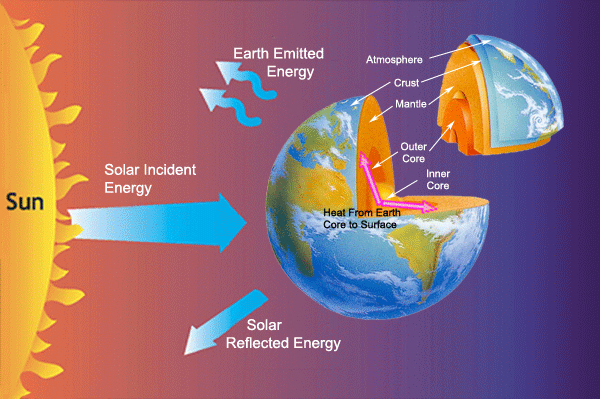The Earth’s climate system is complex, influenced by numerous factors, both natural and anthropogenic. Among the multitude of forces affecting climate change, one might wonder about the role of the Earth’s core heat. This article delves into the intricacies of how geothermal energy interacts with global warming and whether it bears any significance in the broader climate discourse.
Foremost, let us clarify the distinction between external and internal contributors to Earth’s temperature. The Sun, a nuclear furnace, primarily governs the planetary climate through solar radiation, heating the atmosphere and oceans. However, beneath the surface lies the Earth’s core, a molten mass of iron and nickel, which generates heat through radioactive decay and residual heat from the planet’s formation. The core’s temperature reaches up to 5,500 degrees Celsius, an astounding internal energy source. Yet, the crux of the matter lies in whether this geothermal heat is a viable contributor to contemporary global warming.
To comprehend the implications of the Earth’s core heat on climate change, one must explore the mechanisms through which this heat is transmitted to the surface. The heat from the core escapes to the mantle, and by means of convection, it reaches the crust, influencing geological and hydrothermal phenomena. Hot springs and geysers are superficial manifestations of this geothermal energy but represent only a fraction of the core’s contributions. The bulk of the core’s heat dissipates into the lithosphere, contributing to a relatively stable temperature gradient. This raises a critical question: Does this inherent geothermal stability significantly pertain to the climate crisis ignited over the last century? The answer remains cumbersome to ascertain.
Geothermal energy is considered a renewable resource, harnessed in many regions for electricity generation and heating purposes. However, its contribution to the atmospheric conditions that precipitate global warming is incidental at best. While volcanic eruptions (a manifestation of geothermal energy) can temporarily affect climate by injecting ash and sulfur dioxide into the atmosphere, the long-term global effects are overshadowed by anthropogenic greenhouse gas emissions. Factors like carbon dioxide, methane, and nitrous oxide, primarily released from fossil fuel combustion, industrial activities, and agriculture, create an atmosphere conducive to the greenhouse effect. This phenomenon traps heat and leads to the rising global temperatures associated with contemporary climate change.
Exploring further, one must consider the role of geothermal energy systems in combating climate change. As a clean and sustainable energy source, geothermal power presents a viable alternative to fossil fuels. When utilized appropriately, it can immensely reduce our carbon footprint, illustrating an exciting avenue for mitigating environmental degradation. Nevertheless, this beneficial utilization remains vastly overshadowed by the extensive carbon emissions from human activities. Thus, while the Earth’s core heat can be harnessed to our advantage, it is not a direct contributor to the process of global warming.
A critical aspect to bear in mind is the temporal scale at which these geological processes occur. The core generates heat continuously; however, the thermal influence on climate scales into geological epochs, rendering its immediate impact negligible. This contrasts starkly with the rapidity of climate change observed in modern history, primarily driven by human actions in a minuscule timeframe relative to Earth’s geological history. Therefore, attributing global warming to core heat not only misrepresents scientific understanding but also detracts from urgent mitigation measures needed to address the greenhouse gas emissions that pose immediate existential threats.
Moreover, the Earth’s heat flow varies considerably across different geographical locations, influenced by tectonic activity, ocean currents, and atmospheric conditions. These local variations can induce climate anomalies but do not contribute directly to the overall warming of the planet. For instance, regions with high geothermal activity may experience localized climatic changes, but these phenomena are again eclipsed by the global ramifications of atmospheric carbon concentration.
In conclusion, while the Earth’s core heat is an essential aspect of terrestrial dynamics, its role in contemporary climate change is minimal compared to the pervasive impacts of anthropogenic greenhouse gases. The fusion of geothermal energy into sustainable practices offers prospects for alleviating climate change, reflecting a foundational shift in how we perceive energy sources. Yet, we must remain focused on the primary driver behind global warming: our relentless carbon emissions resulting from fossil fuel dependency.
The discourse surrounding the Earth’s core and global warming is a vital reminder that scientific inquiry must always strive for clarity amidst the misperceptions surrounding climate change. Enhanced understanding will foster informed decision-making, inspiring innovative solutions that prioritize environmental stewardship. In this pivotal moment for humanity, we must not lose sight of the true culprits of climate change, remaining vigilant in our collective response to ensure a sustainable future.







